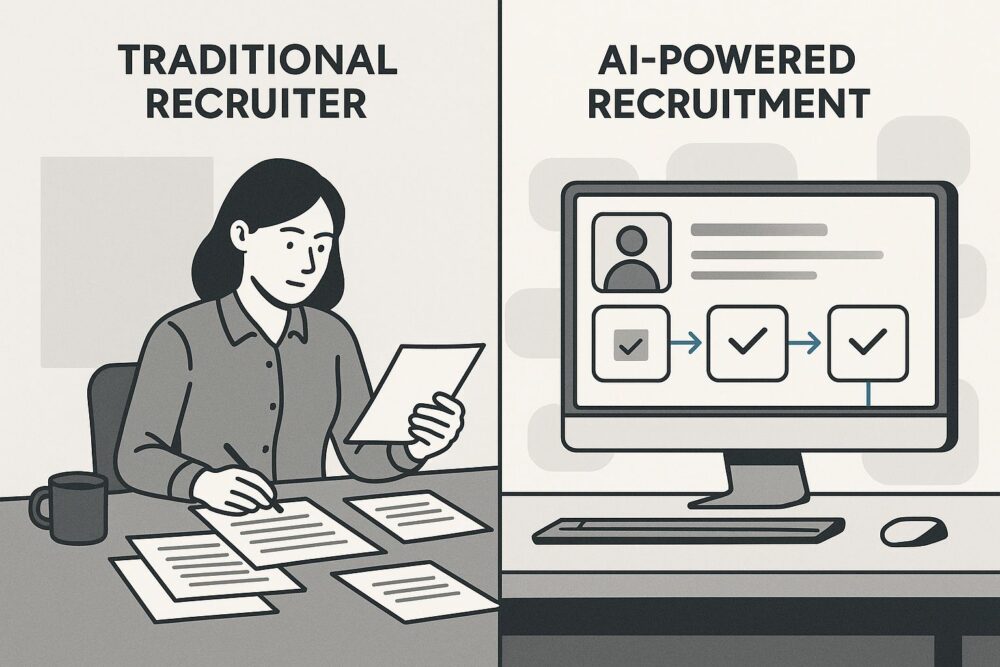AI Revolution: The recruitment industry stands at a crossroads. Perplexity CEO Aravind Srinivas recently made a bold prediction that his company’s AI browser, Comet, could completely automate recruiters and administrative assistants with just “one prompt.” This isn’t just another tech prediction it’s a fundamental shift that could reshape how organizations handle their most critical human resources functions.
The One-Prompt AI Revolution in Recruitment
AI Revolution: “A recruiter’s work worth one week is just one prompt: sourcing and reach-outs,” Srinivas declared during The Verge’s Decoder podcast. This statement encapsulates what many consider the most significant transformation in recruitment technology since the advent of applicant tracking systems.
The implications are staggering. Traditional recruitment processes that involve hours of candidate sourcing, database management, and personalized outreach could be condensed into a single AI command. Srinivas demonstrated scenarios where Comet could identify Stanford graduates who had worked at Anthropic, organize their data in Google Sheets, and prepare tailored cold emails for each one.
What Makes Comet Different from Traditional Recruitment Tools
AI Revolution: Unlike conventional recruitment software that requires manual operation at every step, Comet functions as an autonomous agent. The AI can “keep following up, keep track of responses, update Google Sheets, mark status as responded or in progress, sync with Google Calendar, and resolve conflicts to schedule meetings.”
This represents a paradigm shift from recruitment tools that assist human recruiters to AI systems that could potentially replace them entirely. The technology integrates seamlessly with existing platforms like Gmail, LinkedIn, and Google Calendar, creating a comprehensive recruitment ecosystem that operates independently.
The Administrative Assistant Automation Wave
AI Revolution: Beyond recruitment, Srinivas envisions Comet transforming administrative roles across organizations. The AI agents are capable of managing schedules, paperwork, and follow-ups, effectively taking on administrative roles as AI models continue to improve.
The scope of administrative automation includes:
Calendar Management: Autonomous scheduling with conflict resolution and automatic meeting preparation
Email Management: Intelligent filtering, prioritization, and response generation
Document Processing: Automated data entry, spreadsheet updates, and report generation
Communication Coordination: Managing multi-party correspondence and follow-up sequences
The Technology Behind the Revolution
Srinivas described his broader vision to turn Comet into an AI operating system one that continuously runs tasks in the background and follows natural language instructions with ease. This isn’t just about improving efficiency; it’s about creating digital employees that never sleep, never take breaks, and can handle multiple complex workflows simultaneously.
The artificial intelligence revolution the business model reflects this ambitious scope. Srinivas suggested people might spend “$2,000 for a prompt” if it helps generate significant business value. This pricing strategy indicates confidence that AI automation will deliver ROI that justifies premium costs.
Industry Implications and Market Response
AI Revolution: The recruitment industry, worth over $200 billion globally, faces unprecedented disruption. Traditional staffing agencies, corporate HR departments, and recruitment technology providers must now grapple with the possibility that their core functions could be automated.
Artificial intelligence AI Srinivas warns that “people who are at the frontier of using AI are going to be way more employable than people who are not.” This creates a clear divide between organizations and professionals who embrace AI integration and those who resist it.
The Competitive Landscape
Other tech leaders share similar views about AI’s disruptive potential. Anthropic CEO Dario Amodei has said AI could replace half of all entry-level roles within five years. Ford’s CEO Jim Farley echoed that concern, warning that AI could “replace literally half of all white-collar workers.”
However, not everyone agrees with this assessment. Some industry leaders position AI more as a productivity enhancer than a job replacement technology. This divergence in vision creates opportunities for organizations to differentiate their approach to AI adoption.
Challenges and Limitations
AI Revolution: Despite the ambitious promises, Srinivas admits that the Comet browser struggles with complex “long-horizon” tasks. Nevertheless, he expects it will reach its full potential within the next six to twelve months. Intelligence revolution and why.
Current limitations include:
Complex Decision Making: Multi-stakeholder recruitment decisions still require human judgment
Cultural Fit Assessment: Understanding company culture and personality matching remains challenging for AI
Legal Compliance: Employment law requirements and bias prevention need human oversight
Relationship Building: Long-term client and candidate relationships benefit from human interaction
The Human Element in HR
AI Revolution: While AI excels at data processing and routine tasks, human resources fundamentally involves human connection. The most successful recruitment and administrative functions combine AI efficiency with human insight, emotional intelligence, artificial intelligence revolution and strategic thinking.
Preparing for the AI-Driven Future

Organizations looking to leverage AI in recruitment and administration should consider a phased approach:
Phase 1: Process Automation – Implement AI for routine tasks like candidate screening and calendar management
Phase 2: Workflow Integration – Connect AI systems across multiple platforms and processes
Phase 3: Strategic Implementation – Use AI insights to inform hiring strategies and organizational planning
Skills Development for HR Professionals
AI Revolution: HR professionals must evolve their skill sets to remain relevant in an AI-dominated landscape:
AI Literacy: Understanding how to work with and optimize AI systems
Strategic Thinking: Focusing on high-level planning and decision-making
Emotional Intelligence: Leveraging uniquely human capabilities in relationship management
Data Analysis: Interpreting AI-generated insights for strategic advantage
The Timeline for Transformation
Srinivas expects Comet to reach its full potential within the next six to twelve months. This aggressive timeline suggests that organizations have limited time to prepare for significant changes in how they approach recruitment and administration.
Early adopters will likely gain competitive advantages through reduced costs, improved efficiency, and enhanced candidate experiences. Organizations that delay AI integration risk falling behind competitors who embrace these transformative technologies.
Economic and Social Implications
AI Revolution: The broader implications extend beyond individual organizations. The AI agent is not merely a new feature. It is a catalyst for a profound and potentially brutal transformation of the white-collar workforce.
Economic Impact: Reduced employment in traditional HR roles, potential cost savings for organizations, and new job categories focused on AI management
Social Considerations: Need for workforce retraining, income inequality concerns, and societal adaptation to AI-driven employment changes
Regulatory Response: Governments may need to address employment disruption and establish guidelines for AI use in hiring
Looking Ahead: The Future of Work
AI Revolution: Srinivas offers an optimistic view, suggesting that this newfound efficiency will free up humanity’s time and attention. He believes people will spend more time on leisure and personal enrichment.
This vision assumes a smooth transition where AI handles routine work while humans focus on creative and strategic activities. However, the reality may be more complex, requiring careful management of the transition period and support for displaced workers.
AI Revolution: The recruitment revolution powered by AI represents both unprecedented opportunity and significant challenge. Organizations that thoughtfully integrate AI capabilities while maintaining human oversight and strategic thinking will be best positioned to thrive in this new landscape.
As we stand on the brink of this transformation, one thing is clear: the future of recruitment and administration will be fundamentally different from today. The question isn’t whether AI will transform these functions, but how quickly organizations will adapt to harness its potential while addressing its limitations.
Companies that use AI as a partner, not a threat, will win. MahadHRC is ready to guide you through this transformation.

